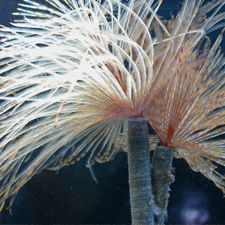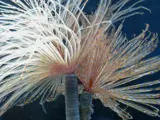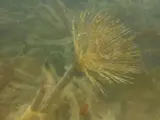 Mediterranean fanworm (Sabella)
Mediterranean fanworm (Sabella)
Common name: Mediterranean fanworm
Botanical name: Sabella spallanzanii
Management programme: Progressive Containment
Where is it originally from?
The Mediterranean fanworm was first detected in New Zealand in 2008 and is now present in a number of harbours around the country. It is known to regenerate damaged body parts, while the worm continues to function.
It is thought to have arrived in New Zealand as an unwanted hitchhiker on a vessel, either as larvae held in ballast water or as hull fouling.
Why is it a pest?
- Mediterranean fanworm form dense beds that are likely to out-compete other species for food and space.
- It can form colonies of up to 1000 individuals per square metre.
- It is a highly effective filter feeder.
- In high densities is likely to impact commercially important species (mussels, oysters, scallops, etc).
Where is it found?
- They are generally found on hard sub-tidal structures but can also be buried up to 10cm deep in soft substances.
- Larvae may survive up to 20 days before settling permanently, potentially travelling long distances on currents.
- It prefers sites protected from wave action.
- Mediterranean fanworm can be spread on vessels, primarily as hull fouling. Although the movement of aquaculture equipment or other marine structures may also contribute to its spread.
- Elimination programmes are underway in the Coromandel, Tauranga, and Nelson harbours.
What does it look like?
- Large, tube dwelling, aquatic worm, measuring up to 20mm wide and 800mm long.
- It has a prominent crown of feeding tentacles that extend out of the tube and can be 150mm wide.
- This crown is often banded orange, purple, or white
- The tubes are leathery, flexible, and muddy looking
- It can be mistaken for the New Zealand native fanworm. They can be differentiated as Mediterranean fanworm is larger, has a single fan (rather than the two of the NZ species) and it often has a banded crown or fan.
What are the rules?
Progressive Containment
Progressive Containment species are pests which the Council aims to prevent from spreading, reduce the distribution, or eradicate within parts of the region over time. Landowners or occupiers are responsible for the control of Progressive Containment species on their property. Council may enforce the control of these pest species.
What are the rules around keeping boat hulls clean and transporting of marine pests?
- Keep your boat bottom and any niche areas clean (no more than light slime, all the time).
- Keep your anti-fouling paint fresh - manufacturers usually recommend replacement every 1-2 years.
- Check your hull before you travel to a new area, every time.
- If your boat is heavily fouled, haul it out. Cleaning underwater will only spread any pests that may be hiding on there.
To prevent the spread of marine pests, Bay of Plenty marinas require visiting vessels to have been recently cleaned. That means:
- Antifouled in the last six months.
- Lifted and washed in the last month.
Tauranga marinas have their own hull hygiene rules for visiting vessels. Some high-risk vessels may be subject to additional marina requirements. Plan ahead - contact Tauranga Bridge Marina on 07 575 8264 or Tauranga Marina on 07 578 8747 for details.
How do you get rid of it?
It is important to ensure vessels are clean from invasive pests before entering the Bay of Plenty.
If you spot Mediterranean fanworm in the Bay of Plenty, please kill it, keep the sample and contact the Bay of Plenty Regional Council on 0800 STOP PESTS (0800 786 773).
Images


